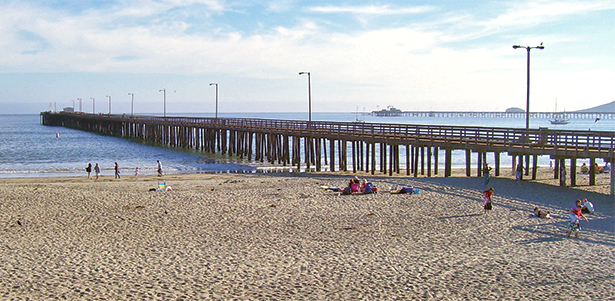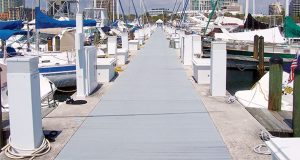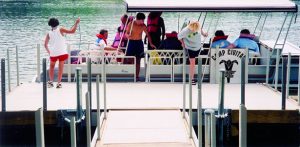Best Practices to Design Storm Proof Piers with Fiberglass

First thing’s first: this author acknowledges that making anything truly “storm-proof” is impossible, as nature can’t be fully predicted. However, recognizing what forces storms generally impose: strong winds, waves, flooding, etc., and taking steps to counteract those forces, can help designers and engineers give piers the best chance to stand up to even the most powerful storms.
One of the best choices to make is the right materials for storm-prone areas. Pultruded structural FRP (commonly simply referred to as “fiberglass”) is an excellent structural material in corrosion-prone coastal environments and offers several important benefits over other available options. We’ll look more closely at some of those specific benefits throughout this article. One last preliminary item: those unfamiliar with using structural FRP often fear the process is far different than designing with traditional materials. It isn’t! There are considerations to be made, but let’s look at those key considerations and steps in creating piers, ready for the fiercest weather events, made from fiberglass. You’ll find they are quite similar to using any other material, but offer the benefit of increased confidence in long-term performance, reduced weight, and increased design flexibility (to name a few):
Structural Design:
Load Analysis: Conduct a thorough analysis of the expected loads, including wind, wave, and surge forces that the pier may encounter during storms. This analysis should comply with relevant engineering codes and standards.
High Strength Design: Design the pier structure with a focus on high-strength materials, ensuring that the fiberglass composite used can withstand the anticipated loads. This involves selecting appropriate reinforcements and resin systems. More information, along with many relevant design calculations, is available in Strongwell’s Design Manual.
Material Selection:
 Fiberglass Composite: Choose a high-quality fiberglass composite material with excellent strength, durability, and corrosion resistance. The composite should be specifically formulated for marine applications to withstand exposure to saltwater and environmental elements. Chemical exposure considerations can be reviewed via Strongwell’s Corrosion Resistance Guide.
Fiberglass Composite: Choose a high-quality fiberglass composite material with excellent strength, durability, and corrosion resistance. The composite should be specifically formulated for marine applications to withstand exposure to saltwater and environmental elements. Chemical exposure considerations can be reviewed via Strongwell’s Corrosion Resistance Guide.
Connection and Joints:
Robust Connections: Design robust connections and joints between pier components to enhance overall structural integrity. The connections should be resistant to fatigue and should not compromise the strength of the fiberglass material.
Accessories and Hardware:
Corrosion-Resistant Components: Use corrosion-resistant fasteners, connectors, and other hardware to complement the corrosion-resistant properties of fiberglass. Most commonly, this translates to using 316 SS fasteners or using fiberglass-to-fiberglass connections bolted using a fiberglass stud and nut system, such as Strongwell’s FIBREBOLT®, and bonded with a high-strength epoxy. This assists in preventing the deterioration of the pier's structural integrity over time.
Anchoring and Foundation:
Secure Foundations: Ensure that the pier has a secure foundation by anchoring it to the seabed using appropriate foundation systems. The foundation design should account for the type of seabed and potential storm surges. It is likely this anchoring/foundation system will be the same one used when constructing a pier out of wood, and anchoring methods quite similar in nature.
Wind Load Considerations:
Aerodynamic Design: Consider the aerodynamics of the pier to minimize wind resistance. Streamlined shapes and features can help reduce the impact of strong winds.
Wave and Surge Protection:
Wave Barriers: Design the pier with features such as wave barriers or breakwater elements to minimize the impact of waves and storm surges. This can help protect the structure and enhance its storm resistance.
Monitoring and Inspection:
Regular Inspection: Implement a regular inspection and maintenance program to identify and address any issues promptly. This proactive approach ensures that the pier remains in optimal condition over its lifespan.
Compliance with Regulations:
Regulatory Compliance: Ensure that the design and construction of the “storm-proof” pier comply with local building codes, environmental regulations, and any other relevant standards.
Professional Engineering Input:
 Engineering Expertise: Engage experienced structural and marine engineers to provide input throughout the design and construction process. Their expertise is crucial for creating a storm-resistant pier that meets safety and performance standards. Strongwell has multiple registered structural engineers on staff if questions arise during the design process.
Engineering Expertise: Engage experienced structural and marine engineers to provide input throughout the design and construction process. Their expertise is crucial for creating a storm-resistant pier that meets safety and performance standards. Strongwell has multiple registered structural engineers on staff if questions arise during the design process.
By integrating these considerations into the design and construction process, storm-proof piers made of fiberglass can be engineered to withstand the challenges posed by severe weather conditions, providing a durable and resilient structure. As you’ve seen, the general process of designing a pier with fiberglass is quite similar to creating a pier out of other materials. Changing to fiberglass, however, offers corrosion, strength, and long-term durability benefits that make the structure far superior to one made from those traditional materials.
For more information, reach out to Strongwell today!